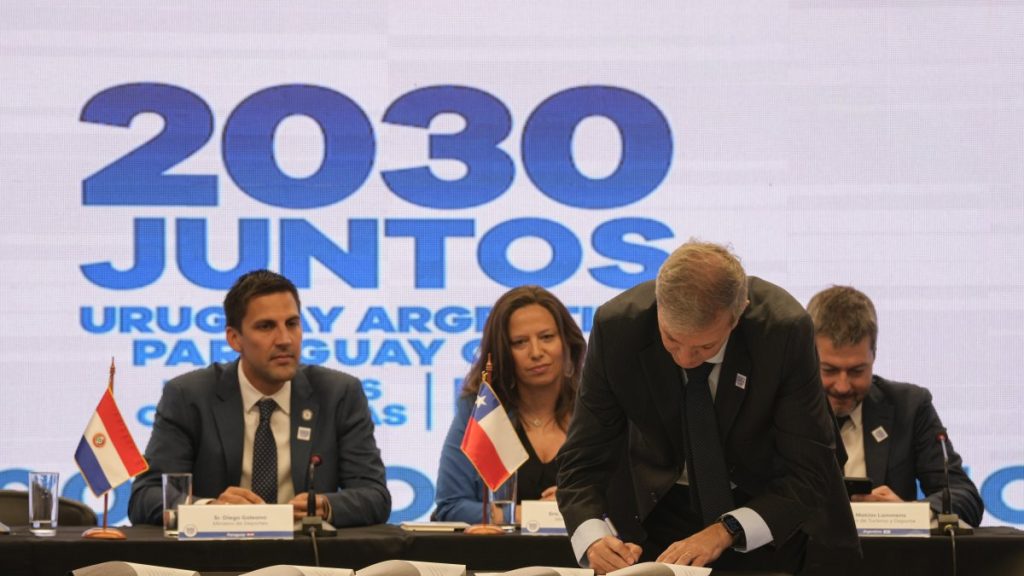As the 2030 FIFA World Cup draws near, anticipation grows over its unprecedented scale, with football teams and throngs of fans set to travel across three continents.
The global journey, however, has raised alarms over the environmental costs of such a vast event.
With an announcement regarding the 2030 and 2034 World Cups expected Wednesday, experts are bracing for a significant expansion in both geography and greenhouse gas emissions.
Skyrocketing carbon footprint
The 2030 tournament promises to be one of the most ambitious in history.
Morocco, Spain, and Portugal have teamed up to host, with Uruguay, Argentina, and Paraguay each slated to hold a match as part of the centenary celebration of the inaugural World Cup in Montevideo.
But the vast distances between host cities – from Europe to South America – mean teams and millions of fans will have to fly, adding to the event’s environmental impact.
Guillaume Gouze, a professor at the Centre of Sports Law and Economics at the University of Limoges, argues that FIFA has a “moral responsibility” to incorporate climate considerations into its plans.
Instead, he labels the 2030 tournament a “ecological aberration,” with the potential to exacerbate the already severe environmental footprint of global sporting events.
Controversial choices
The decision to spread the World Cup across three continents has sparked sharp criticism. Benja Faecks, a representative from the NGO Carbon Market Watch, describes the geographic spread as an “unfortunate” choice, given the logistical nightmare it presents.
“When the event is stretched across such vast distances, teams and fans must travel by plane, leading to a spike in carbon emissions,” she said.
David Gogishvili, a researcher at the University of Lausanne, added that while FIFA aims to promote global access to football, this “crazy idea” comes at a significant environmental cost.
Experts argue that FIFA’s 2026 expansion, which will see 48 teams competing across Mexico, Canada, and the U.S., might be even worse.
Aurelien Francois, a sports management professor at the University of Rouen, notes that more teams mean more fans, greater demand for hotels and services, and increased waste generation.
FIFA contends that with the exception of matches in South America, most of the 2030 World Cup will be played in countries with developed infrastructure and transport links, minimizing environmental impact.
Commercial partnerships under fire
Meanwhile, FIFA’s partnerships have also come under scrutiny.
Earlier this year, Saudi Aramco, a major oil and gas company, became a prominent sponsor for the World Cup.
This controversial deal, running until 2027, has sparked outrage, particularly after over 100 female professional footballers from 24 countries signed an open letter calling for its cancellation. The letter condemned the partnership on human rights and environmental grounds, with one critic saying, “FIFA might as well pour oil on the pitch and set it alight.”
Fan zones and sustainability efforts
While shrinking the geographic footprint could help, experts say it won’t be enough.
The 2022 World Cup in Qatar was a “compact” event, but the need for new, air-conditioned stadiums that were rarely used afterward highlighted the environmental costs of such developments.
Some researchers, like Gogishvili, suggest FIFA should avoid awarding the World Cup to cities still under construction, following the model of the International Olympic Committee’s rules.
To curb air travel, experts propose reserving a significant portion of tickets for fans within a few hundred kilometers of the stadiums, encouraging train travel instead of flights.
Another option is to increase the number of fan zones in cities around the world, allowing fans to experience the tournament’s atmosphere without the need to travel long distances. But such initiatives would require FIFA to rethink the economic model of the World Cup, which currently prioritizes profitability over sustainability.
A Changing Fanbase and the Future of Global Tournaments
Ronan Evain of Football Supporters Europe notes that today’s football fans are increasingly environmentally conscious, a shift that reflects broader societal trends.
While co-hosting a World Cup, as seen in the 2002 tournament in Japan and South Korea, is not inherently problematic, the scale of the 2030 event has raised questions about its environmental costs.
Fans also face rising costs and logistical challenges as they follow their teams across continents.
Despite these concerns, passionate supporters remain undeterred. Antoine Miche, director of Football Ecologie France, points out that “passion can make you do things that don’t make sense,” suggesting that many fans will prioritize their love for the game over the environmental costs of long-haul flights.


